Developing a strong value proposition is an essential component of successfully bringing a product to market.
The best value props are brief statements that outline what makes your product unique and necessary – and why your target audience should choose it. In this sense, it really can make the difference between a prospective customer giving you their business or choosing to go with your competitor.
Such is the importance of crafting powerful value propositions, we've created this complete guide that walks you through everything you need to know about value props. We'll begin by defining value propositions, before unpacking how to articulate your key differentiators via compelling statements that will resonate with your target audience.
By the end, you'll have an actionable framework and template for developing a value proposition that chimes with the wants and needs of your prospective customers – and, most importantly, drives conversions.
Whether you're looking to improve an existing value prop or create one from scratch for a new product or service, this guide will provide practical tips and examples to help you showcase the true value of your product.
Let's get started!
What is a value proposition?
A value proposition communicates how your product or service will benefit your customer. Your value prop should outline why your product is essential for your target segment, how it will solve their pain points, and why your product is more desirable than others on the market.
Time is of the essence when communicating your value to a prospective customer; research has suggested you have between 5 to 30 seconds to hold the attention of a visitor to your landing page before they take their custom elsewhere.
Why is a value proposition important?
Your value proposition is important as it allows your customers to understand the value of your products. It also helps customers to see your product's benefits and helps persuade them that your product is the best option to solve their problems.
How does a value prop fit in your comms?
Value propositions can often be confused with other types of marketing communications. Let's examine the differences between value props, positioning statements, marketing messaging, taglines, mission statements, and brand promises.
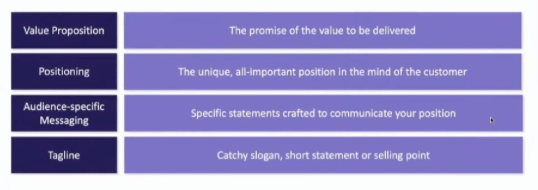
Value proposition vs product positioning
First off, your value proposition is your promise to the customer. It's the promise of the value you're about to deliver. Positioning, on the other hand, is more about the position you want to occupy in the mind of the customer. A shortcut to that is the category:
- What category are you in?
- Are you a cybersecurity firm?
- Are you an HR SaaS company?
- Are you an infrastructure player?
- Are you a storage company?
Sometimes positioning is similar to a category in the mind of the customer. That's not a value prop, that's positioning.
Value proposition vs messaging
Messaging is all about communicating directly to specific target personas. In this sense, it's far more specific and targeted than a value proposition that might be more general. Where a value prop seeks to convey an overarching promise, marketing messaging is far more targeted and geared towards connecting with specific customer segments.
Value proposition vs tagline
Value propositions are often confused with taglines, but they're entirely different. A tagline is a short, catchy phrase that acts as a sales selling point. The value prop, by contrast, is the underlying promise of the value that will be delivered by the product.
Value proposition vs mission statement
A mission statement explains a brand’s purpose for existing whereas a value proposition shares the value of your product.
Value proposition vs brand promise
The brand promise focuses on the long-term meaning of the brand, while the value proposition focuses on products and features.
Which business functions use value propositions?
Value propositions are not intended to be used as-is by salespeople, or put up on websites to be used as slogans or taglines. Instead, it's important to think of value props as foundational statements that different business functions can use and build from.
Copywriters
Copywriters will take the value proposition and turn that into copy for your website.
Branding team
A branding team will start with the value prop when doing advertising, digital and media buys, or ad copy. Among other things, they're going to need personas, your branding, strategy, etc. But the value prop is used by those professionals.
Digital marketers
To create compelling and efficient digital marketing campaigns, you need to who you're targeting, and why that target audience should choose your product over those of your competitors. This information will all be contained within a powerful value proposition.
Graphic designers
Designers are going to want to create a visual representation of your value prop. Creative, different design logos, images, graphics, all those elements should reinforce your value proposition and they should be consistent. They are going to be consumers of your value prop.
Sales enablement
The sales enablement team will need to use the value prop for sales training materials, battlecards, and playbooks.
How to format a value proposition
There isn’t a universally accepted way of creating value propositions; what works for one company could be unsuitable for another.
However, while a value proposition can be presented in any number of ways, a basic formula applied by many companies includes:
- A headline
- A sub-headline
- Key benefits of the product or service
- An accompanying image
When you’re creating your value proposition, it’s essential to write an eye-catching headline; on average, 8 out of 10 people will only read the headline, with just 2 out of 10 opting to read the rest. However, if your headline is enticing, this will prompt your readers to check out the rest of the content - you need to nail your messaging.
Headlines should be short, concise, and snappy, to grab the attention of your readers. This will entice them to read the sub-heading, in which you can explain the benefits of your product further. When the time does come to provide more information, hone in on the key features most relevant to your buyer personas - use this opportunity to pique their interest and identify with your key messaging.
Finally, include a carefully selected image to tie all the aforementioned components together and reinforce what you bring to the table. Don’t be influenced by aesthetics. Any image included should bring value and solidify your value proposition. For example, a picture of people using, and enjoying, your product.
3 key elements of a killer value proposition
The Aventi Group shares insights into elements of a great value prop.
"There are three things that are key if you're going to create a killer value prop, almost like a litmus test."
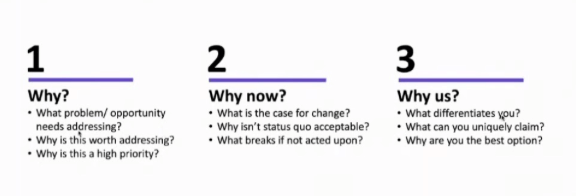
Why?
"What is the problem we're trying to solve? It's got to solve a specific job that a person is trying to achieve. On the customer side:
- What problem are we trying to solve?
- Is it really worth solving that problem?
- Is it nice to have?
- Is it a critical pain point?
- How high of a priority is it?"
Why now?
"We also want the value prop to speak to why now? That's the case for change or the case for action.
"Though a lot of times customers are fine, don't be afraid to disrupt the status quo and make a move. A value proposition should be compelling, actionable, and urgent - if change is needed to make this happen, then so be it.
"It needs to convey some level of urgency, and maybe a little bit about the consequences of inaction. What if you don't move forward, what's at stake here?"
Why us?
"The third thing is why us? We need to get the differentiator in the value prop because it's not enough to say why and why now you also want to distinguish why your company, and why your solution.
"You're going to need to make some claims that should be defensible, backed up by proof points, concrete and measurable. That helps to reinforce why we are the best option."
How to write a value proposition: example
The Aventi Group highlights some examples of value propositions.
"I'm going to give you two flavors, a short version, and then a long version. And I'm going to give you three specific client examples. These might be templates for you to think about."
Value proposition: facility management SaaS example
"The first example I'm going to use is a SaaS company. They're in the facility management software space, full disclosure, they're a client of ours called 4insite.
"They sell software to large organizations that have a lot of facility workers. Think of custodial staff, think of electricians, plumbers, landscapers, all those contract folks who come into buildings or facilities to maintain the facility."
The short version
"This is the short version of the value prop.

4insite
"4insite helps organizations connect, analyze, manage, and empower their frontline staff.
"That's very concrete, it may not sound exciting to you but I will tell you the persona we're speaking to is dealing with these issues here. Let's go through this one by one."
Why?
"Manual processes. The current pain is facility executives, VPs, directors are fed up with a lot of manual processes, very disconnected tools, managing all these workers and it could be literally hundreds of workers on site.
"With a pandemic going on there are extra concerns about safety and compliance. Unions are concerned about the health and wellbeing of the workers, so the why is very compelling, you can't have that kind of situation."
Why us?
"So you need ideally a SaaS solution that is built specifically for facility management."
Why now?
"Because you're losing customers, there are customers that are unhappy with the quality issues, the bathrooms aren't totally clean or the facilities are not being maintained or not safe and the facility companies are choosing other competitors.
"This gives you a little feeling about what the value prop looks like."
The long-form version
"I know this is a little bit of an eye chart so I'll just spend a moment to go through this.
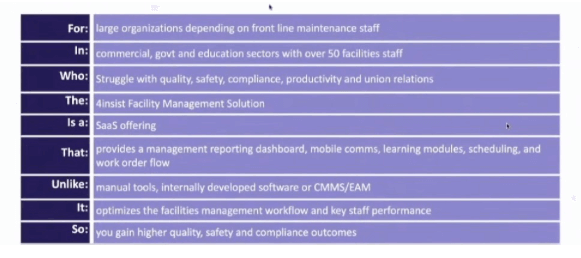
"This is a tool that product marketing folks have used for decades. It's been around a long time, a Stanford professor. I think his name is Lynn Phillips. It originally coined the long-form value prop.
"When I was a HP executive, we were trained on this long-form tool. This is just the tool for product marketing folks, you don't necessarily need to share this out with everybody.
"In this example, I'm sharing with you 4insite, we start off with who are the target companies you're going after? Large organizations that have a large frontline staff, at least 50 of those. This is similar to the ideal customer profile.
"Who are they? These are companies that have some pain in quality, safety, compliance, union issues. This is the positioning, the category, 4insite is a facility management solution, a SaaS offering.
"That's the mental bucket we want customers to think, "Oh, you're a SaaS offering or software company, you're not a services company, you're a software company". That's the positioning. Now, this is what we're delivering, this is what 4insite does, it’s reporting, dashboard, mobile communications, all this stuff here.
"The differentiator here is versus manual tools, which are a pain in the neck, they lead to all kinds of quality problems, compliance problems, safety problems.

"And there's an option which sometimes customers have internally developed software so that's a competitor. That's the do-nothing scenario. That's the status quo scenario.
"The reason to go with 4insite is it optimizes that facility workflow so you can get higher quality, you can have higher quality, higher safety, higher compliance, these are the things that they care about - the outcomes.
"Notice, we don't talk about feature function, we're talking about outcomes, we're driving higher quality.
"That's one example of a long-form. Again, it's a bit pedantic, it takes a lot of work to go through this."
Value proposition: security software example
"This is a security software company, I'm going to do the same thing."
The short version
"Here's the short version of the value prop statement.

"A little context, Absolute is a security software company, if you have a Windows laptop, maybe it's a Dell, maybe it's an HP or Lenovo, it's very likely you have this software running on your laptop, it's at the BIOS level, it's down almost at the metal.
"Now, this software is super important because it manages and secures data, devices, and applications that are unbreakable. The keyword here is unbreakable.
"Endpoint means the device, that could be your laptop as an example. Sometimes your laptop is off the internet, and you're not online. Even in that scenario, this laptop is unbreakable. Let's go through our three whys."
Why?
"The first ‘why’ is customers are looking to protect their data. They don't want to be hacked, they don't want information to get out. They don't want their devices to get hacked.
"Ransomware is a big deal now, you've all heard about the SolarWind's hack and many hacks going on that are damaging. So companies/organizations are afraid of being hacked. That's a big reason."
Why us?
"Why Absolute? The keyword is unbreakable. It really is unhackable because it's down at that almost metal level. It's at the BIOS level, which hackers can't get access to."
Why now?
"I mean, can you afford to be hacked and wind up on the front page? You don't want to be the next story in the Wall Street Journal or online media. This is a real fear that a lot of chief information security officers have.
"They don't want the board coming to them saying why didn't you do something about this? So this is a super compelling solution and this is a compact value prop statement.
"How do we get to this?"
The long-form version
"Here's the long-form version, I'll walk you through that.
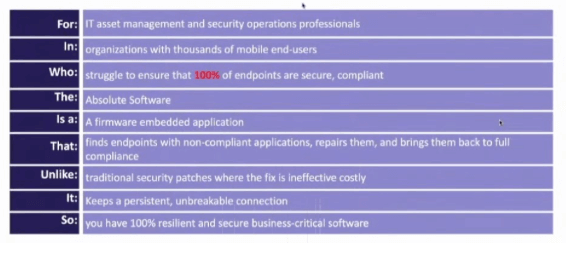
"At Absolute, they're targeting the IT organization, the IT Asset Management Director, all security operations professionals. Those are the ones whose neck's on the line. They're the ones who will get fired if there's a breach or they're the ones who will get promoted if their environment is really secure and very locked down.
"What kind of organization? Absolute is not targeting small businesses and customers they're really targeting the largest organizations with 1000s of users.
"Who specifically? It's the IT organizations that are struggling with compliance, how do you protect all those endpoints? An endpoint again, is a laptop, typically a laptop, iPod, your phone, any device where you're doing work.
"How do you guarantee 100% of those devices are secure and compliant? Well, Absolute, and this is the category remember, they're a firmware embedded application, they're software but they're firmware embedded, unlike enterprise software security, for example, or unlike a SaaS cloud pure plane solution, this is embedded application. That's the category, that's the positioning.
"What Absolute involves is it finds those endpoints that are noncompliant, puts them back into compliance, and repairs them. That's the job the customer is trying to do.
"The IT person is trying to make sure all these devices are getting back in compliance because a lot of times they fall out of compliance, they don't have the latest patches, they don't have the latest antivirus, they don't have the latest OS updates.
"That's the job the IT person is trying to do and unlike traditional security patches, a lot of times they fall out of working, when you go offline, those security patches are not enforced. They're not working. They're not effective, or they're costly.
"So what is key here is it's persistent meaning even if you're online, offline, you reboot your machine, no matter what that Absolute embedded application is running, it's unbreakable.
"That's a really powerful value proposition statement, this idea of unbreakability. That's the core of the message here, the core of the value proposition is it's unbreakable, and that ensures a resilient environment. So as customers are changing their desktops, things are happening, no matter what that device is locked down.
"That's the long-form value prop we used. And again, this is used only by the product marketing team, this long-form in order to help the copywriters, the designers, the sales enablement team also come up with the copy blocks that are necessary."
Value proposition: enterprise services example
"Here's the third one."
The short version
"This is a large corporation, Unisys, and this is one of their services offerings. It's called Workplace Solutions. It's not software, it's services. It's actually a set of capabilities.

"The idea here is to engage, empower, and transform the digital workforce. Now everyone nowadays is digital, we're all pretty digital warriors. Some companies are more digital and more reliant on productivity. Let's talk about the why."
Why?
"Lots of companies are investing heavily in remote access, digital, digital everything, digital workflows. It's key to stay ahead of your competition."
Why us?
"So you need a company that is experienced, it’s objective. We are a service partner to help deploy this full digital workplace."
Why now?
"Well, your competition is already moving to digital, they’ve already transformed their enterprise. So let us help you catch up and overcome and exceed your competition."
The long-form version
"This is what the product marketing team and we here at Aventi crafted.
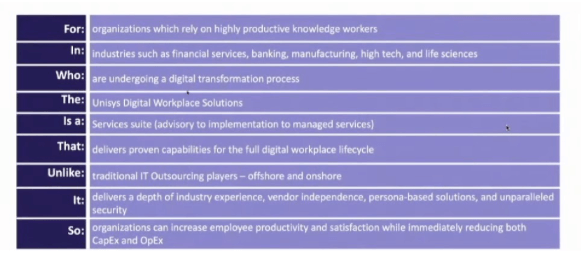
"We start off with the target customer, the ideal customer profile, we are looking for large organizations that are super dependent on so-called knowledge workers. These are people who are primarily delivering information and analysis and you're hiring them for very much their brains.
"Where is that important? In banks, insurance companies, manufacturing companies, high tech, life sciences, pharmaceuticals, all those companies are relying on scientists, engineering, financial analysts, so super important to make them productive.
"Those companies we are targeting only the ones that are committed to digital transformation, they may even have a Chief Digital Transformation Officer. So we can look for clues that this target ICP - ideal customer profile, is going after digital transformation.
"What is Unisys digital workplace? It's a services offering, starting off from advisory to implementation into managed services. This has a special meaning for customers who really need help, they're understaffed, they don't have the right expertise, they're short on IT and they just really need help.
"That's where services come in. Unisys has a proven capability, the whole digital lifecycle. Unlike traditional IT outsources that may be offshore. I won't name names, but you can guess a lot of the traditional IT outsourcing companies. What Unisys specializes in is industry experience, they have deep experience with financial services, banking, manufacturing.
"They're also neutral, meaning they're not trying to push one software solution or set of software, they're really doing what's right for the customer. They're persona-based so there are different buyers within these enterprises. And they offer some pretty deep security.
"These are some of the differentiators, all of these, by the way, have proof points behind them.
"Lastly, who cares? So this is all great, but what impact is it going to have? This goes to the heart of the value prop, the value prop is about business value. We're going to drive higher productivity, and that's going to also improve their capital expenditure and operating expenses.
"You do want to catch the 'so'; 'so' is the business benefit - but why does this matter?
"Those are three long-form examples of customer value propositions."
More value proposition examples
What is Apple's value proposition?
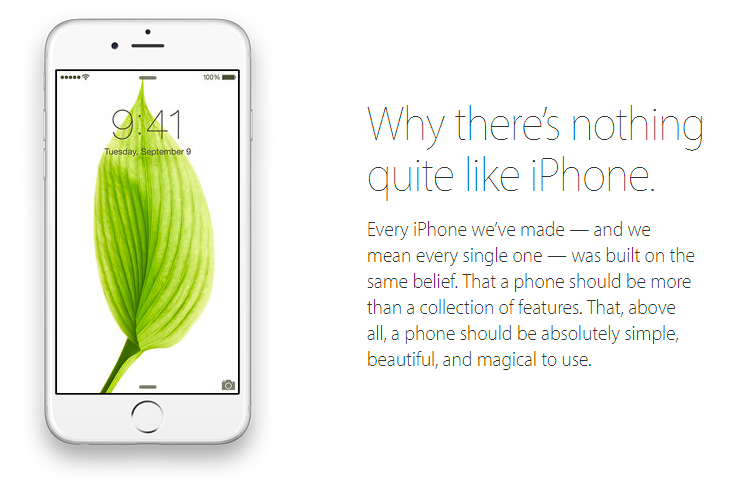
What is Unbounce's value proposition?
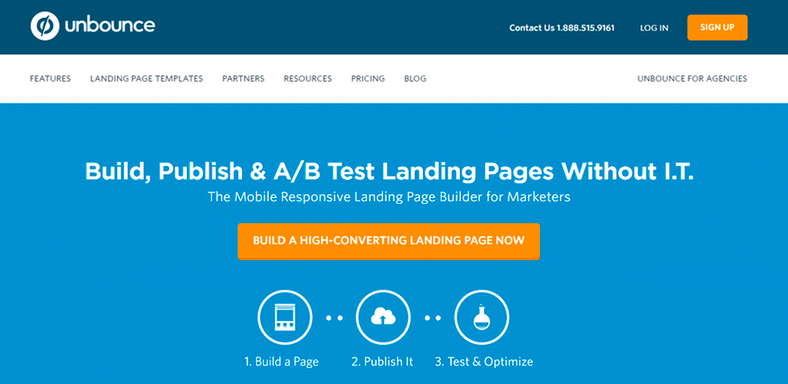
What is Slack's value proposition?
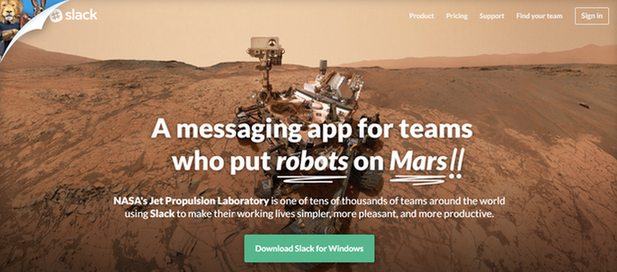
How to create a value proposition
A strong value proposition is essential for any company, and can be achieved by completing four steps:
Research your audience
If you don’t understand what’s motivating your audience, how can you produce a value proposition that’ll resonate with them and convince them to buy your product?
Researching the market will allow you to identify what kind of language is appropriate to include to ensure that you’re able to pinpoint the USP of your product effectively.
If you have an existing customer base, conduct customer and market research sessions. This will provide you with essential information on how your product is already helping them in their daily lives.
Always ask questions that’ll help you establish:
- The type of language you should be using - craft your messages with prospective customers in mind, and speak their language. For example, if your target segment is 16-24-year-olds, colloquial language would be justifiable. On the other hand, if you’re creating messaging for middle-aged professionals, this wouldn’t be appropriate.
- Their problems and pain points - You need to present yourself as the definitive solution to the problem. If a prospect doesn’t consider you to be the best option on the market, they’ll take their custom elsewhere.
In some instances, feedback from your customers may indicate what you initially considered to be your main selling point isn’t held in the same esteem among your customers, in which case, you need to reposition your product and reevaluate your initial messaging.
Create buyer personas
Buyer personas are crucial, as they help you understand your customers from a human perspective - what motivates them to purchase a product? What features do they value most? These questions offer the information you need to create a value proposition that resonates and leads to them purchasing your product.
How to create buyer personas
Your personas need to be built with real information from real people - using your gut instinct won’t do. And remember, creating personas is all about understanding audiences you already know want to buy from you; not people you wish would buy from you.
Buyer personas can be created in four steps:
Step 1: conduct thorough research
Start by sifting through your records to see what kind of information you’ve already got on your customers. It’s unlikely you’ll stumble across everything you need to build a robust persona, but at the very least it’ll give you a jump start.
Some other outlets to gather information include:
- Adding relevant fields into any forms on your website;
- Communicate with sales teams - they’re talking to these people day in, day out after all;
- Introducing useful questions to your customer onboarding process; and/or
- Interviewing existing customers face-to-face or over-the-phone - this option will usually provide you with the richest information.
Tip: if you’re struggling to get people to say ‘yes’ to an interview start by making it clear it’s not sales-driven, give them flexibility around days and times, and think about adding an incentive.
If you’re picking up insights from several different sources remember to create some sort of forum for it all to be collated - it doesn’t need to be complicated, something as simple as an Excel spreadsheet with clearly defined headings would do.
There isn’t a set number of people you need to speak to. The more the better, but, as a rule, for a persona to be considered credible you should aim for between 5 - 10 matching patterns.
Step 2: understand your aims
The two core areas you should be aiming to understand are:
- What problems people are trying to solve, and
- What they want to achieve.
This kind of intel is golddust for your marketing efforts because it enables you to relate to their motivations and tailor-make your proposition to their wants and needs.
As well as A and B above though, get around a table at the outset and think about anything specific to your business that would come in handy - the last thing you want is to realize you missed something key later down the line.
Step 3: ask the right questions
There are endless questions you could ask, but here are a few ideas to help you hit various touchpoints and create a holistic picture:
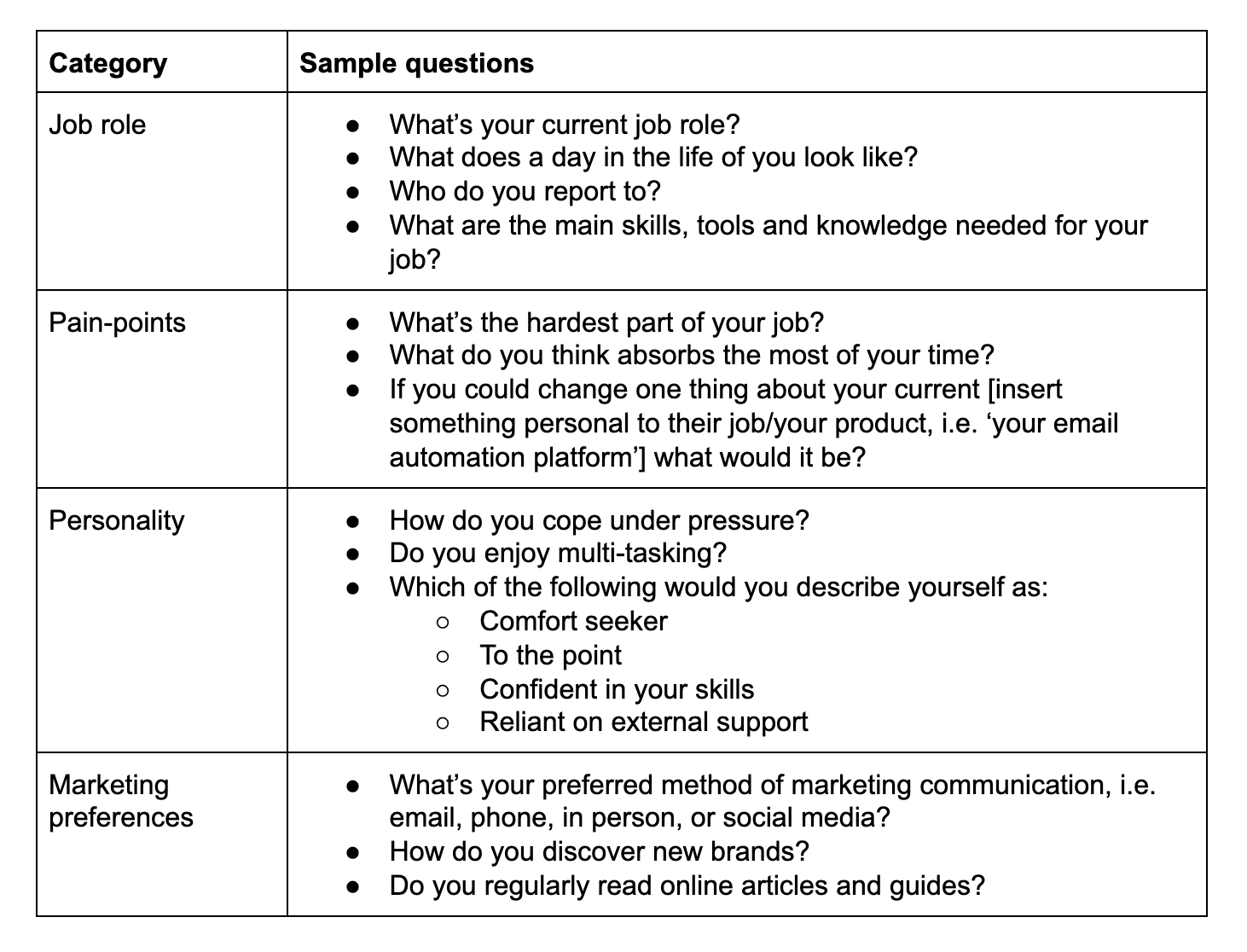
Step 4: collate your learnings
By this point, you should have insights coming out of your ears. To turn them into something actionable and meaningful, start by grouping common characteristics - it’s important not to rush this stage or make any hasty generalizations.
Go through everything with a fine-tooth comb and only solidify an assumption if you’ve got enough evidence to go off.
To help you get from A to B, here’s an overview of the types of areas you’ll want your personas to cover:
- Job title and decision-making authority
- Gender, age, and geographic location
- Communication preferences
- What they’re struggling with
- Their overarching aims
- How your product or service helps
- How you should position your marketing messaging.
One of your buyer personas might look like this:
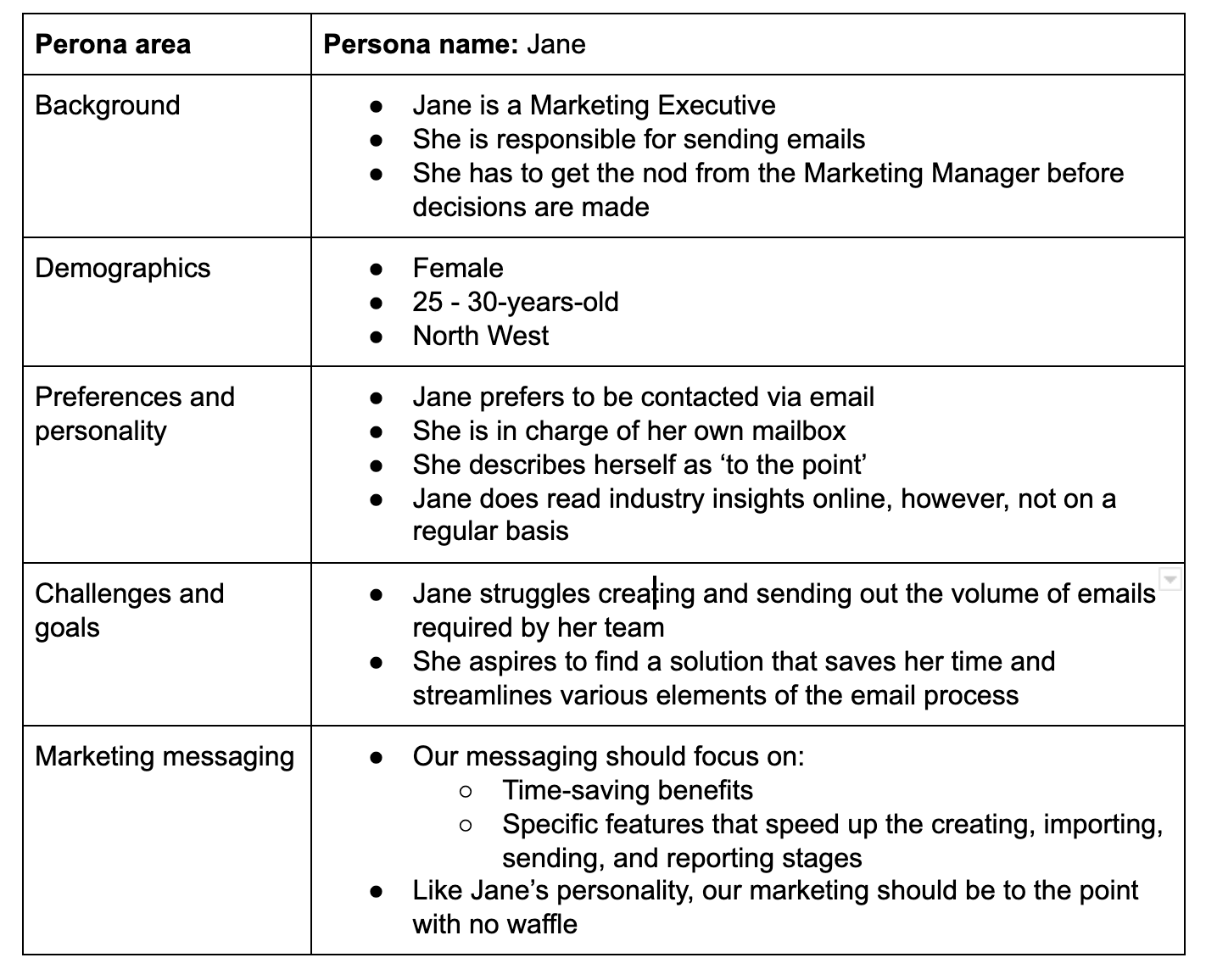
When you’ve identified your target audience, you need to develop your product messaging and product positioning. Your positioning statement will be used to communicate your value and highlight the benefits of your product, above those of your competitors.
Be sure to answer key questions, such as:
- What can you offer your customers?
- What value do you bring to the table?
- How will you solve the customer’s pain points?
Complete competitive intelligence
Never assume you’re the market leader. You need to conduct thorough competitive intelligence to establish what other businesses are doing, and if they’re offering something different, you need to develop your product to surpass the competition.
If a customer has a choice between two competing products doing the same thing, you’re relying on the toss of a coin. However, if you’re offering a differentiating feature, this can easily set you apart and see company revenue and customer retention increase, with customer churn falling.
Product marketers shared their competitive intelligence tips:
“Don’t be afraid to get help from other parts of your organization. Being able to get help from a Sales Engineer or a Developer while you’re reading technical documentation can save a ton of time and help you better understand different personas.”
Mindy Regnell, Marketing Insights Manager at BigCommerce
“Job postings reveal a lot about your competitor's product/growth strategy. They’ll often disclose which areas they're trying to invest in on a technology perspective or which customer segments they're trying to grow the business in the most.”
Julian Clarke, Senior Product Marketing Manager, Team Lead at Lattice
“Spend time getting to know the competitor from all angles: explore their website and gated assets as if you were a prospect, but also understand from their existing customers if the true product experience matches the initial marketing.”
Megan Magee, Product Marketing Manager at ServiceNow
“Start with your value proposition not mentioned by you, but by your customer. From there, understand why you don’t live up to that value proposition and where you can improve. Know your segment, know your buyer and persona.”
Hien Phan, Director of Product Marketing at Formation
“Social media is a goldmine of information.”
Avi Goldstein, Manager of Vendor Relations and Product Marketing at Hertz Furniture
“Keep an eye on your peers, but don't lose sight of why your company is unique. That's the story you want to focus on getting in front of your customers. We've found that when we check all of the right boxes, our customers spend less time comparing us to others and more time asking us what else can we do together?”
Jessica Munoz, Senior VP of Product Marketing at LiveIntent, Inc.
“Hearing what customers say has been the most fruitful competitor intel - using tools like Gong and G2 help to gather that info.”
Andrew McCotter-Bicknell, Product Marketing Manager at ZoomInfo
“Read the cons on all the reviews - even the 4-star review has something they don't like. I analyze this for trends so we can rebuke any objections to a sales pitch.”
Maureen West, Director of Product Marketing at 6sense
“Communicate with your customers who have switched from a competitor. They're the source and can articulate pain points which are more valuable than market-facing positioning from the competitor.”
Miles Price, Senior Product Marketing Manager at Sailthru

Identify the main benefit of your product
Having identified your buyer persona and competitors, you need to establish the main benefit of your product.
In some cases, there may be multiple reasons you think a customer should use your product or service.
For example, Uber acknowledges the frustrations associated with ordering a ‘traditional’ cab, before highlighting why users should use their app instead. They have three features that could be deemed USPs: a car comes directly to you, your driver knows exactly where to go, payment is cashless. However, the collective USP is that commuters can order a cab at the touch of a button - that’s what users are interested in most.
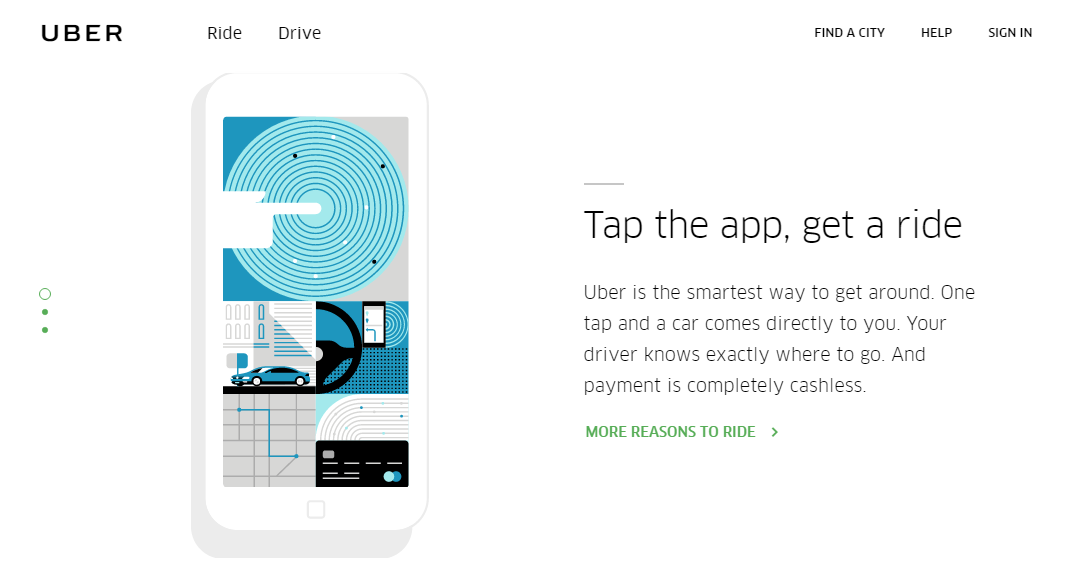
Statistics make the world of difference. Go above and beyond and provide specific stats to demonstrate how purchasing your product will enhance their lives and/or business.
Let’s stick with Uber to explain our point. If they said “Uber reduced commuting time in 2020” this doesn’t carry as much weight as “in 2020, Uber helped over 93 million users per month reduce their journey time by an average of 15 minutes”. The difference is there for all to see; statistics help you to express concrete value.
These four steps are key to creating a value proposition that ties together your customer needs, what the market offers, and what you’re offering.
How to test a value proposition
When you’ve created your value proposition, it’s important to test it to establish whether it resonates with your audience. Complete a test run by following these five simple steps:
- Define who you are targeting and what benefits you are bringing them
- Build a simple landing page
- Set up a cold email / LinkedIn outreach campaign
- Launch outreach to them
- Evaluate if the offer resonates or fails
A cold campaign serves as the true acid test for your value proposition; if you’re able to convert prospects you’ve never approached before, the chances are you’ve created a value proposition ticking all the right boxes.
Judge your value prop with an 8-point test
The Aventi group also shares some ways to test the impact of your value proposition.
"Now, one way to test your value proposition is we have a little eight-point test here. Eight questions to ask yourself after you've created the long-form version of the value prop or the short term, does it speak to a specific customer segment?"
1) Is it speaking to a specific customer segment or it it too generic to be useful?
"Don't be generic, like all large enterprises, we need to be specific, what industry, what size organization? What are some of the pain points? We don't want to be generic, we want to be specific."
2) Is it customer focused?
"Is it customer-specific? Is it all about you, the vendor or is it all about the customer and their pain point?"
3) Will it resonate with the target customer? How do we know?
"Does it resonate? This is where testing is important, we need to know that this value prop actually is resonating. How do you know?
"Because customers have told you, you vetted this with at least 10 quality qualitative interviews and maybe hundreds of quantitative surveys."
4) Does it differentiate from competitors including the "status quo?"
"Differentiation - make sure you clearly state including the status quo, including the do-nothing scenario where the customer thinks it's a pain but it's not enough to go do a purchase and then deployment, we don't want to go through the headache.
"Differentiation is important, sometimes your number one competitor is “do nothing”. It's people just saying I'm good enough."
5) Is it believable?
"Is it credible?"
6) Is it emotional - can a customer connect with it?
"Is it emotional? By the way, a lot of times I see value props that are really engineering, very heady, very intellectual, that's great. But what drives the buying process, the buying journey, the buyers’ journey is often the emotional driver.
"Sometimes in the security world, I deal with a lot of security, software companies, cybersecurity, and fear is a big driver. You don't want to be talking about fear but you want to understand that the chief information security officer, the IT folks, they're afraid of getting hacked.
"And that emotion is important to understand and acknowledge in your process. Sometimes emotion, maybe excitement, and maybe power or confidence. Tap into the emotion in your value prop."
7) It is using customer language, not jargon?
"Sometimes we tend to speak jargon, I deal with a lot of B2B technology companies and they use a tonne of acronyms. Try to stay away from that, use words that customers use. Be careful about that."
8) It is clear, compelling, and credible?
"Lastly, is it compelling? Is it credible? Is it clear? Your message testing will really confirm that."
Unlock the secrets to growth and master monetization.
For successful product-led growth, being able to create immense customer value is the name of the game. But without the tools to effectively capture this value, your product can end up short-changed and your company’s growth can grind to a halt.
This is where Product-led Pricing Certified: Masters comes in.
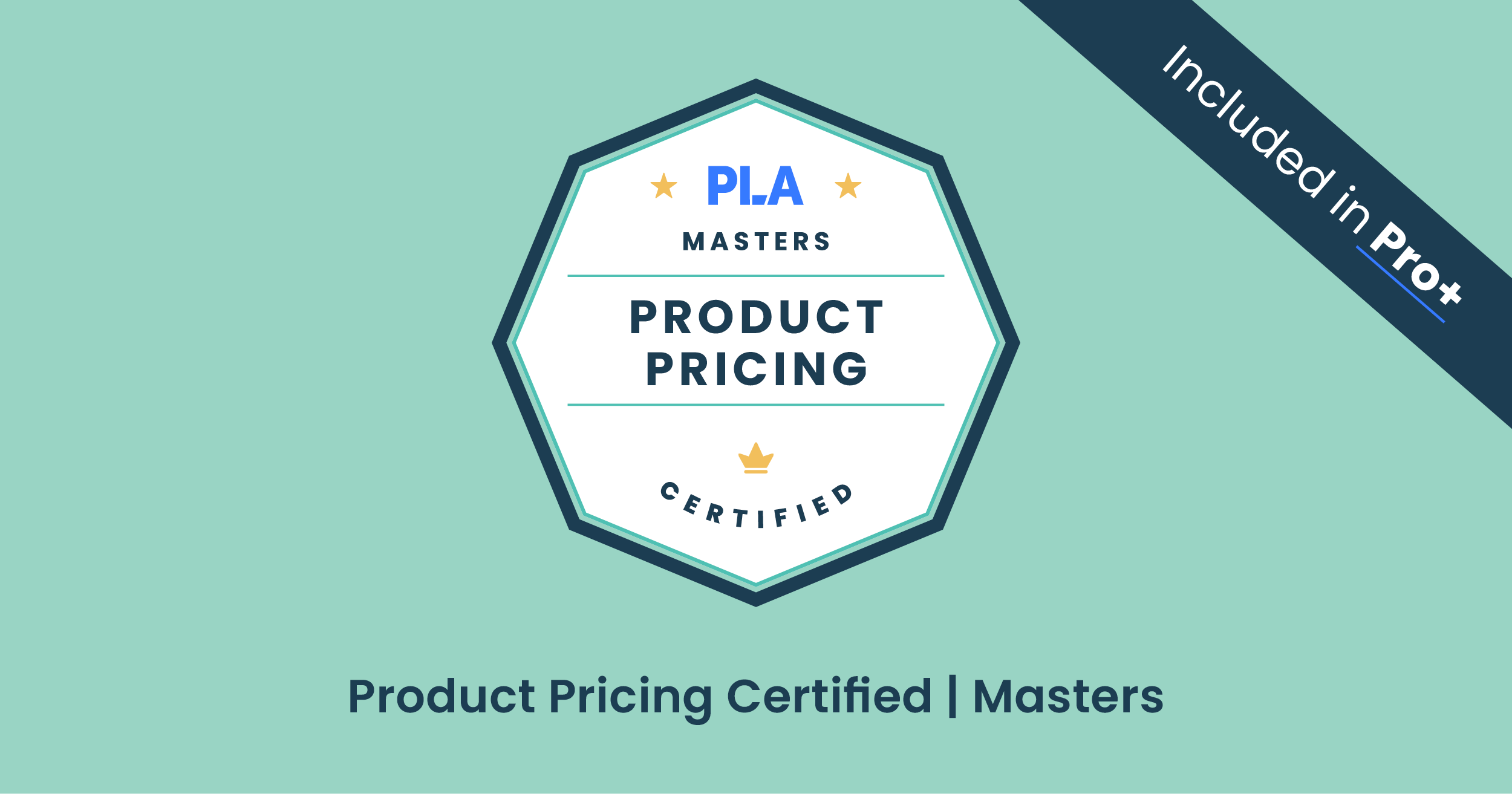



 Follow us on LinkedIn
Follow us on LinkedIn



